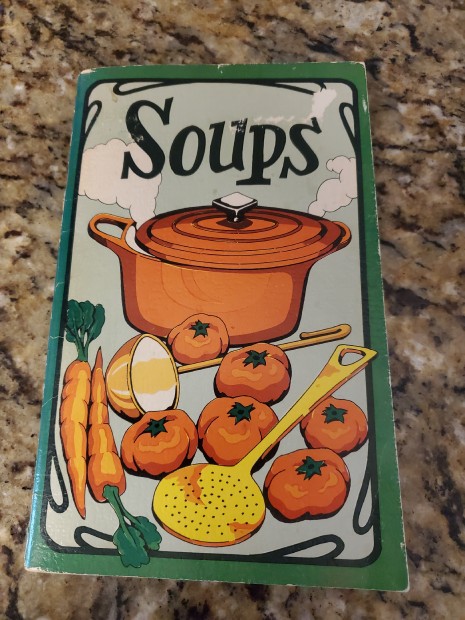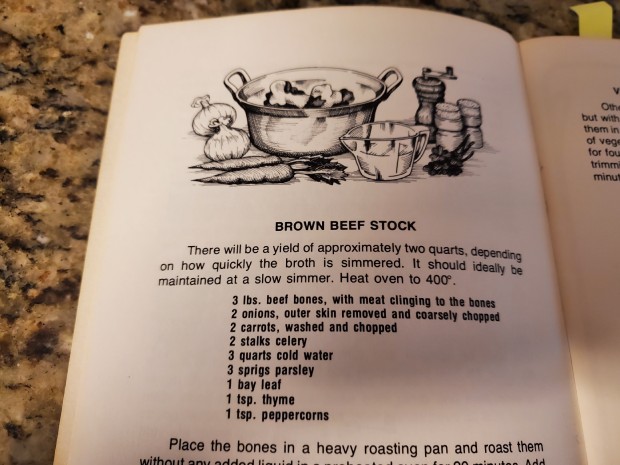Brown Beef Stock or Broth (Call it What You Want)
There are so many articles on beef stock, you really don’t need me to tell you how to make it. A lot of people are still buying prepared stock from the grocery store that is mostly water, salt, and artificial coloring. Homemade beef stock is nutritious, delicious, cost-effective, and simple to prepare! So, I’m sharing my recipe to help inspire you to ask us for a beef stock bone next time you’re in Lanier’s instead of buying a box of stock at the grocery store.

About the Dish
While bone broth is trendy these days, it’s been around for centuries. The Chinese used bone broth in medicines 2,500 years ago to strengthen the kidneys and aid digestive health. It soon became a staple in Asian meals. Other cultures viewed broth as an inexpensive way to feed large families and take advantage of every part of the animal. It’s even mentioned in the Bible (“Take the meat and the unleavened flatbread, put them on this stone and pour the broth”).
French chefs elevated this humble dish, turning it into consommé, bouillon, and stew. With the invention of the bouillon cube in 1910, home cooks were able to create their own simplified version of bone broth. Today, it’s enjoying a resurgence thanks to its health benefits.
Why Homemade Beef Stock is Better
The bone broth diet has grown in popularity in recent years, and the corporate gourmet food market has responded with expensive high-end beef bone products priced ridiculously (from $7 for a 16.9 oz. box and upward.
Bone broth is low in calories and high in protein. It is comprised mostly of water and will help with your body’s hydration needs. Bone broth does contain small amounts of vitamins and minerals, mostly from the vegetables cooked with the bone. It does contain rich amounts of protein and amino acids such as glycine and proline, which your body uses to make its own collagen
A list of benefits compiled by the Canadian Digestive Health Foundation can be found here.
Bone Health
Osteoporosis is marked by a reduced level of collagen in the bones and therefore increased poor bone quality. More protein, more collagen (glycine and proline) = better bones.
Gut Health
The nutrients in bone broth — collagen, gelatin, glycine and glutamine — have all been shown to soothe gut irritation and inflammation, strengthen the gut barrier, and reduce the presence of LPS in the blood.
Brain Health
Broth made with marrow bones will provide the fat your brain needs for fuel and help maintain its structure.

Original Recipe
Recipe Source: Soups by Irena Chalmers, illustrations by B. Penny, copyright 1975.
Irene Chalmers was a nurse and midwife before she changed career directions and attended the Le Cordon Bleu in London. In addition to running her own culinary schools and gourmet shops, she taught at The Culinary Institute of America. Chalmers is credited with creating the first cookbooks devoted to single subjects, such as microwave cooking and ice cream. She had this take on bone stock:
“There are so many good canned and dehydrated broths readily available on the market for soup, and they are certainly acceptable enough in an emergency. However, for a truly great soup — a soup that will strengthen your body, lift up your soul, make your hair curly and your eyes shine — you must make your own broth from an unlikely collection of bones, fresh vegetables, herbs, and plenty of long slow simmering time.”
I’m pretty sure that bouillon cubes never made anyone’s eyes shine. Let’s make better food from better ingredients that are, believe it or not, less expensive than pre-made shelf-stable grocery store options.
Ingredients:
- 3 lbs. beef bones, with meat clinging to the bone
- 2 onions, outer skin removed and coarsely chopped
- 2 carrots, washed and chopped
- 2 celery stalks
- 3 quarts cold water
- 3 sprigs of parsley
- 1 bay leaf
- 1 tsp. thyme
- 1 tsp. Peppercorns
Directions:
- Heat the oven to 400 degrees. Place the bones in a heavy roasting pan and roast them with any added liquid in a preheated oven for 20 minutes.
- Add the vegetables and brown them with the bones for an additional 15 minutes.
- Discard the fat and transfer all the ingredients to a heavy casserole. Add the water, parsely, bay leaf, thyme, and peppercorns. There should be sufficient water to cover the bones. Adjust the lid so the casserole is almost covered. Leave a space of about an inch to allow some evaporation of steam and concentration of the liquid to take place. Simmer over gentle heat for 6 hours.
- Strain through a colander and discard the bones and vegetables. Do not press the vegetables or the broth will become cloudy. Chill the broth. Skim off the fat that will rise to the surface.
The broth is now ready to use, but remember, no seasoning has been added so it will be necessary to add salt and pepper. There will be a yield of approximately two quarts, depending on how quickly the broth is simmered.
How I Cooked It
Ingredients:
- 1 beef bone
- 3 carrots
- 3 celery stalks
- 3 quarts cold water
- 3 sprigs parsley
- 2 bay leaves
- 2 tsp. of fresh thyme
- 1 tsp. ground pepper
- 1 tbsp. Morton’s seasoning salt
Directions:
- Roast bone at 400 degrees for 20 minutes. Add vegetables and roast for another 15 minutes.
- Move bones and vegetables to the dutch oven. Add water, thyme, bay leaves, pepper, and seasoning salt. Heat over medium heat until simmering.
- When simmering, cover loosely to allow venting and reduce heat to prevent boiling. Allow to simmer on low for 6 hours.
- Strain through a colander and allow it to sit overnight in the fridge. After chilling, remove the layer of fat that has solidified on top.
How to store: Irene Chalmers,Soups (pg9):
“Homemade broth can be stored in the refrigerator for at least two weeks. However, the broth should be returned to boiling point and simmered for 10 minutes every three or four days or it will become sour.
The broth can be boiled down and reduced to an essence. Freeze the stock as it is, or fill it into ice cube trays. Reconstitute the stock with water as it is needed, using taste as a guide to the quantity of water needed.”
My grandfather always said, “Don’t pay someone to do something you can do yourself”. Broth definitely falls into this category because I can make more broth, more nutritious and cheaper than any corporation.


0 Comments